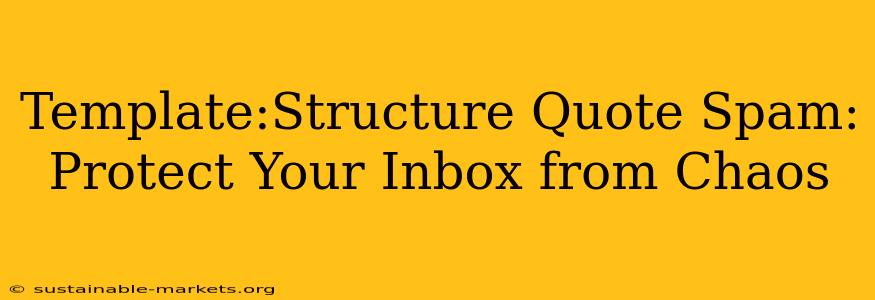Email overload is a modern plague. But amidst the legitimate newsletters and important updates, a particularly insidious form of spam lurks: structure quote spam. This isn't your typical Viagra email; it's more subtle, more sophisticated, and often harder to detect. This comprehensive guide will arm you with the knowledge and strategies to identify, prevent, and eradicate structure quote spam from your inbox, restoring peace and order to your digital communications.
What is Structure Quote Spam?
Structure quote spam, also known as structured quote spam or template spam, is a type of unsolicited email that uses a template or pre-written format to appear legitimate. Unlike typical spam, which often contains blatant errors and obvious scams, structure quote spam is designed to mimic professional communication. They often utilize legitimate-looking headers, footers, and even seemingly professional email signatures. The goal? To bypass spam filters and trick recipients into engaging with malicious links or attachments.
They often appear to be legitimate business quotes, invoices, order confirmations, or shipping updates—all containing subtle, yet crucial, differences from genuine correspondence. These variations often include slightly altered branding, incorrect details (like a slightly off company address), or hyperlinks leading to phishing sites.
How to Identify Structure Quote Spam
Recognizing structure quote spam requires a keen eye and a healthy dose of skepticism. Here are some key indicators:
- Unexpected Emails: Did you request a quote, order, or shipment? If not, treat the email with extreme caution.
- Suspicious Links: Hover over links (without clicking!) to see where they actually lead. Discrepancies between the displayed URL and the actual destination are major red flags.
- Grammatical Errors and Typos: While not always present, minor grammatical errors or typos can be a sign of automated generation or a less-than-legitimate sender.
- Generic Greetings: Emails addressed with a generic "Dear Customer" or "Valued Client" rather than your name should raise suspicion.
- Unusual Email Addresses: Look closely at the sender's email address. Does it align with the purported company? Are there unusual characters or domains?
- Inconsistent Branding: Compare the email's branding (logo, fonts, etc.) to the official website of the company it claims to represent. Even minor inconsistencies can be indicative of fraud.
- Urgent Tone: Many structure quote spam emails create a sense of urgency, pushing you to act quickly before it's "too late." This is a classic tactic to bypass critical thinking.
Common Types of Structure Quote Spam
Understanding the common formats helps you stay vigilant:
- Fake Invoices: These mimic legitimate invoices, often with slightly altered amounts or company details, attempting to trick you into paying a fraudulent bill.
- Bogus Quotes: These appear to be legitimate business quotes for goods or services, often including malicious links disguised as order confirmations.
- Shipping Notifications: Pretending to be from a delivery service, these lure recipients to click on malicious links, often resulting in malware infection or data theft.
How to Protect Yourself from Structure Quote Spam
Proactive measures are crucial in combating structure quote spam:
- Strengthen Your Spam Filters: Utilize advanced spam filtering options offered by your email provider.
- Be Wary of Unexpected Emails: Exercise caution when receiving unsolicited emails, especially those containing attachments or links.
- Verify Information Directly: If you receive an email that seems suspicious, contact the company directly using a verified phone number or email address found on their official website. Never use the contact information within the suspicious email.
- Keep Your Software Updated: Regularly update your operating system, antivirus software, and web browser to protect against the latest threats.
- Educate Yourself and Others: Stay informed about the latest spam techniques and educate your colleagues and family members on how to identify and avoid these scams.
What to Do if You Suspect Structure Quote Spam
If you suspect you've received structure quote spam:
- Do not click any links or open any attachments.
- Report the email as spam to your email provider.
- Delete the email immediately.
- Consider running a malware scan on your computer.
Frequently Asked Questions (FAQs)
How can I tell if an invoice is legitimate?
Always verify invoices directly with the company through official channels – phone, verified email address on their website, etc. Never rely on information within the email itself.
What should I do if I accidentally clicked a link in a structure quote spam email?
Change your passwords immediately. Run a malware scan on your computer and contact your bank or financial institutions to report potential fraudulent activity.
Are structure quote spams always malicious?
While many are designed to trick you into harmful actions, some might be simply poorly crafted marketing emails. However, it's always better to err on the side of caution and treat any suspicious email with extreme skepticism.
Can my spam filter block all structure quote spam?
No spam filter is perfect. Structure quote spam is designed to evade detection, so a multi-layered approach, including vigilance and careful verification, is essential.
By understanding the characteristics of structure quote spam and employing the strategies outlined above, you can significantly reduce your risk of falling victim to these sophisticated scams and keep your inbox clean and safe. Remember, vigilance is your best defense.

